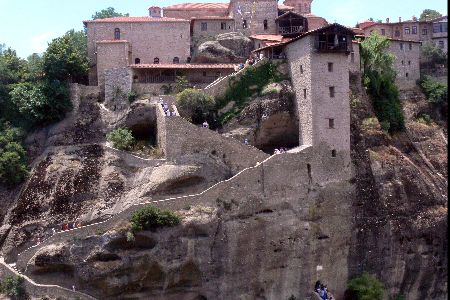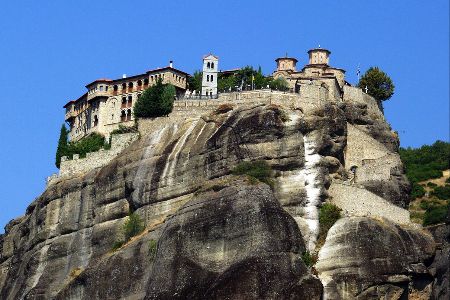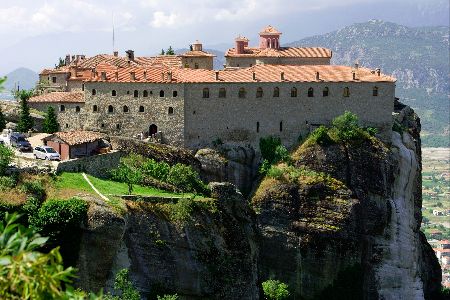Meteora Monasteries
The Monasteries of Meteora
On the western edge of the plain of Thessaly, where the Pinios River emerges from the deep canyons of the Pindus range, one comes upon a unique phenomenon of nature. 24 gigantic, perpendicular rocks, on which about 600 years ago Byzantine monks chose to worship God and built Meteora, their monastic community. How the monasteries were built on the top of these virtually inaccessible rocks is a subject of fascination for pilgrims and visitors alike. These gray stalagmites etched by time into a variety of shapes, rising towards the sky, appear as nature’s gift to the pious that have opted for solitude and a life of worship. The monasteries, with their wooden galleries and cornice rooftops, crown the summits of these formidable pinnacles.
Meteora is the Greek word for the suspended rocks, a name that attributes completely the spectacle you see when you reach the plain of Kalambaka and you see the imposing and stunning rocks.
In the late Byzantine period and during Ottoman rule this monastic community became a sanctuary of the persecuted. On these barren and inaccessible rocks, a center of Byzantine art was created. The history of the Meteora monastic community begins in the 11th century. During the 9th century, hermits settled in the caves and crevices of the rocks. On Sundays and important holidays they gathered in Doupiani, near Kastraki (where the monastery and church of the Virgin Mary were later built), to read mass. As monks increased, the cloisters of Doupiani and Stagi were created.
The wild and inaccessible landscape of Meteora became the “shelter” for the Christian ascetics who settled in the area, on a date that is not exactly known, but is estimated around 1100 AD. The steep cliffs, which appear to have come from the sky, are located near the first hills of Pindos and Hassia, above the towns of Kalambaka and Kastraki, in the Thessalian plain, in the center of mainland Greece. On the peaks of some of the rocks of Meteora, there are monasteries built, making the area the second most important monastic complex in Greece, after Mount Athos.
At their peak in the sixteenth century there were 24 monasteries at Metéora but only six (the Mansions of the Transfiguration of the Savior, the Holy Trinity, St. Nicolas of Anapache and Varlaam, and the women’s monasteries of Rousanos and St. Stephen) are currently operating and included in the UNESCO World Heritage List.
Meteora Monasteries is one of the second most important groups of monasteries in Greece, after Athos. It is set in a region of almost inaccessible sandstone peaks; the monks chose this unearthly place to settle their monasteries on the “columns of the sky” as they are called, from the 11th century onwards.
The monasteries on the Meteora rocks have been characterized by Unesco as a unique phenomenon of cultural heritage and are included in the list of World Heritage sites.
These vertical rocks have also become a favorite destination for rock climbers, who follow the steps of the 11th-century hermits when they were climbing the rocks in order to settle in the caves and fissures of the rocks. On Sundays, the monks would clamber down from their cells to celebrate the mass in Doupiani in Kalambaka.
Meteora has been featured in the James Bond film "For Your Eyes Only" and in the Angelina Jolie film "
Tomb Raider - Cradle of Life". Tweet
Where to stay near Meteora
The near town of Kalambaka that took its name from the Turkish word for pinnacle, stretches at the base of the Meteora rocks and monasteries. Kalambaka is a well-developed town, providing accommodation for overnight visitors.
You have the option of staying in Kalambaka or Kastraki village when visiting Meteora. You can choose from a selection of wide variety of hotels and guesthouses to discover the ideal place for you. Enjoy the view of the Meteora rocks from the balcony of a quiet or luxurious accommodation.
If you ever find yourself in Meteora with fog, you will really think you are in another world. It is a landscape of unparalleled beauty that is worth visiting, whether you are lovers of natural and wild beauty, or are looking for peace and quiet. On the way from Kalambaka to Kastraki, a road leads to the monasteries of Agios Nikolaos of Bantova and Agios Antonios, which are built in the caves of the rocks.
In addition, the rocks of Meteora are ideal for rock climbers, with many routes for which they can be found here:
Rock Climbing Meteora
In Kalambaka, located in the “shadow” of the rocks, you will find many hotels (often overlooking the imposing rocks), but also restaurants, taverns and cafes. Do not forget to visit the newly renovated old town, where there is the only woodworking school in Greece. Above Kalambaka is the picturesque village of Kastraki, with its beautiful houses, mansions and narrow alleys.
From Meteora and Kalambaka you can also easily visit the picturesque village of Elati, Pertouli with its ski center and the surrounding areas of Aspropotamos and Hassia.
By car
Meteora is 360 km from Athens and 230 km from Thessaloniki. The shortest route is from Domokos – Karditsa – Trikala. Kastraki is 3 km from Kalambaka.
The Holy Land
Twenty-four monasteries were built in the area of Meteora since the 11th century when the first hermits settled in the area. More monasteries were built later during the 14th century despite the immense difficulties because of the particularities of the region. The Meteora monasteries flourished until the 17th century but only six of them survive today; four of these still host monastic communities.

Great Meteoron
This is the largest of the monasteries located at Metéora, though in 2015 there were only 3 monks in residence.
It is well preserved and very impressive, with a very important collection of frescoes and relics.
It was erected in the mid-14th century and was the subject of restoration and embellishment projects in 1483 and 1552. One building serves as the main museum for tourists. The Katholikon (main church), consecrated in honour of the Transfiguration of Jesus was erected in the middle of the 14th century and 1387/88 and decorated in 1483 and 1552.

Varlaam Monastery
The Monastery of Varlaam is the second largest monastery in the Metéora complex, and in 2015 had the largest number of monks (seven) of the male monasteries. It has very elegant church frescoes dating back to the 16th century.
It was built in 1541 and embellished in 1548. A church, dedicated to All Saints, is in the Athonite type (cross-in-square with dome and choirs), with spacious exonarthex (lite) is surrounded by a dome. It was built in 1541/42 and decorated in 1548, while the exonarthex was decorated in 1566. The old refectory is used as a museum while north of the church is the parekklesion of the Three Bishops, built in 1627 and decorated in 1637.

St Stephen Monastery
The Monastery of St Stephen is the only monastery fully visible from the town of Kalambaka. The Monastery of St. Stephen has a small church built in the 16th century and decorated in 1545. This monastery rests on the plain rather than on a cliff. It was shelled by the Nazis during World War II who believed it was harboring insurgents and was abandoned. The monastery was given over to nuns in 1961 and they have reconstructed it into a flourishing nunnery, with 28 nuns in residence in 2015.

Rousanou Monastery
The Monastery of Rousanou/St. Barbara was founded in the middle of the 16th century and decorated in 1560. Today it is a flourishing nunnery with 13 nuns in residence in 2015.
Rousannou Monastery is one of the most easily-accessible monasteries since it is located on one of the lowest rocks of the complex.

St. Nicholas Monastery
The Monastery of St. Nicholas Anapausas, built in the 16th century, has a small church, decorated by the noted Cretan painter Theophanis Strelitzas, in 1527.
Agios Nikolaos Monastery is notable for its unique construction and the amazing frescoes dating back in the 16th-century by the Cretan painter Theophanes the Monk. Strict dress code is enforced for all monasteries: shoulders must be covered and men must wear long trousers while women must wear long skirts.
There was one monk in residence in 2015.

Holy Trinity Monastery
The Monastery of the Holy Trinity is on top of the cliffs. It is probably the most dramatically positioned monastery of the complex, as it is perched on the top of a delicate pinnacle, accessible only by 140 steep steps.
It was built in 1475 and was remodeled in 1684, 1689, 1692, 1741. There were four monks in residence in 2015.
Meteora Monastery Dress Code and Timetable
You are expected to behave respectfully because you will be visiting a religious site of great importance and a place of worship. All men must wear long pants to access Meteora’s monasteries; sleeveless t-shirts and shirts are strictly prohibited. For women, long skirts are required, and shoulders must always be covered. If you don’t have a long skirt to wear, one will be available for you at the door free of charge thanks to the monastery. However, they don’t offer clothing for males. Men should be aware that they will not be allowed entry if they arrive at monasteries wearing very short pants or sleeveless shirts.
Meteora Entrance Fee
3€/person at each monastery. The dress code and entrance fees are not applicable to children under the age of 12.
Monastery Opening Hours
- St. Nicholas Anapafasas: 9am to 5pm summer, closed Fridays. Sundays from 9:30 am to 4 pm during the winter.
- Rousanou: 10am to 4pm summer. 9am to 2 pm winter. Every Wednesday is closed.
- Varlaam: 9am to 3pm summer, closed Tuesdays. Winter hours are 9 am to 2 pm; Tuesdays, Wednesdays, and Thursdays are closed.
- Great Meteoron: 9am to 3pm summer, closed Tuesdays. 9am to 2pm winter, closed Tuesdays, Wednesdays, Thursdays.
- Holy Trinity: 9am to 5pm summer, 10am to 4pm winter. Closed Thursdays year-round.
- Saint Stephen: 9:30am to 1:30pm & 3:30pm to 5:30pm during the summer. 9:30am to 1pm & 3pm to 5pm winter. Closed Mondays year-round.
Art, literature, music and film inspired by Meteora
- Meteora, a 2012 Greek film devoted entirely to a story set in the Monastery of the Holy Trinity, Meteora.
- The monastery of Holy Trinity was a filming location in the 1981 James Bond movie For Your Eyes Only[18]
- Scenes from Tintin and the Golden Fleece were also shot at the Meteora monasteries.
- Michina, the main setting of the movie Pokémon: Arceus and the Jewel of Life is based on Meteora.
- Meteora is the main location in the fiction book The Spook’s Sacrifice, by Lancashire author Joseph Delaney
- The Holy Monastery of St. Nicholas Anapausas was an inspiration for the monastery of St. Francis Folly, in the first level of Greece in both games Tomb Raider and Tomb Raider: Anniversary.
- One of the surviving characters in Max Brooks‘s zombie apocalypse novel, “World War Z” finds refuge and peace of mind in the monasteries during and after the zombie war.
- The 2012 movie Metéora directed by Spiros Stathoulopoulos is set in the monasteries and scenery of Meteora
- Primary location and name of Volume 3 in the comic book series “Le Décalogue” by French author Frank Giroud.
- The Eyrie of Vale of the House of Arryn from Game of Thrones is based on Meteora
- The Call of Duty: Modern Warfare 3 DLC Map “Sanctuary” is set in the monasteries of the Meteora.
- The 2003 album by Linkin Park takes its name from the site.
- The monasteries were a filming location for the 1976 action movie Sky Riders [19] starring Susannah York, James Coburn and Robert Culp.
- Meteora is one of several Greek locations in the fiction book Time Stands Still by California author Stacy Froumis
- In The Young Indiana Jones Chronicles episode “Travels with Father”, Indiana and his father visit Meteor.
Wander. Reveal. Excite.
Pack your bags, choose your path, and let the adventure begin!

